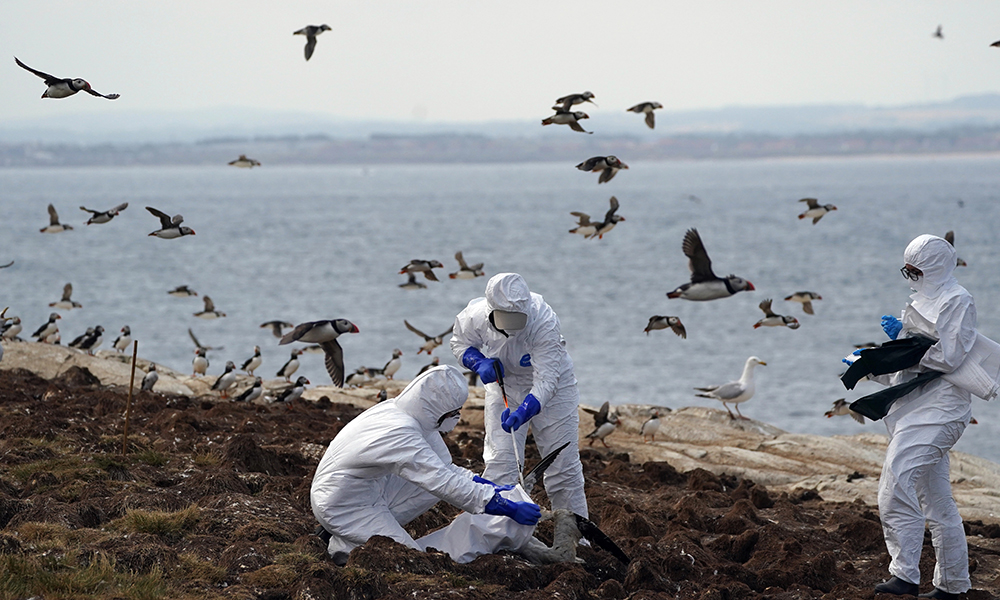今年美国爆发史上最严重的禽流感疫情

今年有近5,300万只鸟类死于禽流感,是美国历史上最严重的一次禽流感疫情,导致节日用火鸡严重短缺。
美国农业部(U.S. Department of Agriculture)在11月29日的一份报告中表示,自今年1月以来,46个州的5,248万只鸟类因为病毒本身或被杀死以遏制传染其他鸟类而死亡。根据联邦数据,绝大多数是家禽,尽管也有数千只野生鸟类。
在今年之前,美国历史上最大的禽流感疫情于2015年爆发,当时美国农业部称之为“可以说是美国历史上最重要的动物健康事件”。
那一年,21个州的5,050万只鸟类死于H5N2和H5N8毒株,这些毒株被美国疾病控制和预防中心(Centers for Disease Control and Prevention)认定为“高致病性”禽流感(HPAIs)。今年影响鸟类的H5N1毒株也被认为是高致病性禽流感。自1月以来,在野生水鸟、商品家禽、后院家禽和业余养殖禽群中发现了这种病毒。
已知一些类似于H5N1的高致病性禽流感会损害鸟类的多个器官,并且能够导致90%至100%感染高致病性禽流感的鸡死亡。好消息是:据美国疾病控制和预防中心称,目前流行的H5N1毒株被认为对人类构成的风险很小,今年迄今为止只报告了一例人类感染禽流感的病例。据世界卫生组织(World Health Organization)称,这名患者是科罗拉多州的一名家禽农场工人,在医院外接受了抗病毒药物治疗,只出现了疲劳的症状。
禽流感以前曾经在人类身上引起从轻微到严重的一系列疾病。因此,美国疾病控制和预防中心敦促人们在工作和家里与鸟类接触时要谨慎。为避免感染禽流感或将其传播给其他鸟类或动物,例如宠物,该机构建议人们:
·尽可能避免直接接触野生鸟类。
·要意识到,携带禽流感病毒的鸟类不一定有发病症状。
·在没有穿戴防护用品的情况下,不要接触看起来生病或死亡的鸟类。
·不要接触可能含有任何种类鸟类的唾液、粘液或粪便的表面,无论是野生的还是家养的,如果你接触了这些表面,一定不要触摸你的眼睛、鼻子或嘴巴。
·接触鸟类后要洗手。
·如果你从事鸟类相关职业,请使用手套、N95呼吸器或更贴合面部的口罩和护目镜等防护用品。
·在处理病禽和/或接触野生鸟类后更换衣服。扔掉你的个人防护用品,用肥皂和水清洗双手。
美国农业部提醒消费者,作为一般预防措施,需要将所有家禽和鸡蛋煮至华氏165度(约73.89摄氏度)。(财富中文网)
译者:中慧言-王芳
今年有近5,300万只鸟类死于禽流感,是美国历史上最严重的一次禽流感疫情,导致节日用火鸡严重短缺。
美国农业部(U.S. Department of Agriculture)在11月29日的一份报告中表示,自今年1月以来,46个州的5,248万只鸟类因为病毒本身或被杀死以遏制传染其他鸟类而死亡。根据联邦数据,绝大多数是家禽,尽管也有数千只野生鸟类。
在今年之前,美国历史上最大的禽流感疫情于2015年爆发,当时美国农业部称之为“可以说是美国历史上最重要的动物健康事件”。
那一年,21个州的5,050万只鸟类死于H5N2和H5N8毒株,这些毒株被美国疾病控制和预防中心(Centers for Disease Control and Prevention)认定为“高致病性”禽流感(HPAIs)。今年影响鸟类的H5N1毒株也被认为是高致病性禽流感。自1月以来,在野生水鸟、商品家禽、后院家禽和业余养殖禽群中发现了这种病毒。
已知一些类似于H5N1的高致病性禽流感会损害鸟类的多个器官,并且能够导致90%至100%感染高致病性禽流感的鸡死亡。好消息是:据美国疾病控制和预防中心称,目前流行的H5N1毒株被认为对人类构成的风险很小,今年迄今为止只报告了一例人类感染禽流感的病例。据世界卫生组织(World Health Organization)称,这名患者是科罗拉多州的一名家禽农场工人,在医院外接受了抗病毒药物治疗,只出现了疲劳的症状。
禽流感以前曾经在人类身上引起从轻微到严重的一系列疾病。因此,美国疾病控制和预防中心敦促人们在工作和家里与鸟类接触时要谨慎。为避免感染禽流感或将其传播给其他鸟类或动物,例如宠物,该机构建议人们:
·尽可能避免直接接触野生鸟类。
·要意识到,携带禽流感病毒的鸟类不一定有发病症状。
·在没有穿戴防护用品的情况下,不要接触看起来生病或死亡的鸟类。
·不要接触可能含有任何种类鸟类的唾液、粘液或粪便的表面,无论是野生的还是家养的,如果你接触了这些表面,一定不要触摸你的眼睛、鼻子或嘴巴。
·接触鸟类后要洗手。
·如果你从事鸟类相关职业,请使用手套、N95呼吸器或更贴合面部的口罩和护目镜等防护用品。
·在处理病禽和/或接触野生鸟类后更换衣服。扔掉你的个人防护用品,用肥皂和水清洗双手。
美国农业部提醒消费者,作为一般预防措施,需要将所有家禽和鸡蛋煮至华氏165度(约73.89摄氏度)。(财富中文网)
译者:中慧言-王芳
Nearly 53 million U.S. birds have died this year due to avian flu, marking the worst outbreak in national history and fueling the holiday turkey shortage.
Since January, 52.48 million birds in 46 states have died because of the virus itself or because they were killed to curb exposure of other birds, the U.S. Department of Agriculture said in a November 29 report. The vast majority were poultry, though several thousand were wild birds, according to federal data.
Prior to this year, the largest bird flu outbreak in U.S. history occurred in 2015, in what the USDA at the time called “arguably the most significant animal health event in U.S. history.”
That year, 50.5 million birds in 21 states died due to strains H5N2 and H5N8, deemed “highly pathogenic” avian influenzas (HPAIs) by the U.S. Centers for Disease Control and Prevention. The strain affecting birds this year, H5N1, is also considered an HPAI. Since January, it’s been detected in wild aquatic birds, commercial poultry, and backyard and hobby flocks.
Some HPAIs similar to H5N1 are known to damage multiple organs and kill from 90% to 100% of chickens they infect. The good news: The H5N1 strain currently circulating is thought to pose little risk to humans, and only one human case has been reported so far this year, according to the CDC. The patient, a poultry farm worker in Colorado, was treated with antivirals outside of the hospital and suffered only fatigue, according to the World Health Organization.
The bird flu has caused a range of illnesses in humans before, from mild to severe. Thus, the CDC urges caution when interacting with birds, both at work and at home. To avoid contracting the bird flu or spreading it to other birds or animals like pets, the agency recommends that people:
·Avoid direct contact with wild birds when possible.
·Realize that birds don’t have to look sick to carry bird flu.
·Don’t touch birds that look sick, or dead birds, without wearing protective equipment.
·Don’t touch surfaces that might have saliva, mucus, or feces from any type of bird, wild or domestic, and certainly don’t touch your eyes, nose, or mouth if you do touch such surfaces.
·Wash your hands after touching birds.
·Use protective equipment like gloves, an N95 respirator or a well-fitting face mask, and eye protection, if you work with birds.
·Change your clothes after working with sick poultry and/or after handling wild birds. Throw away your PPE and wash your hands with soap and water.
The USDA reminds consumers to cook all poultry and eggs to an internal temperature of 165˚F as a general precaution.













